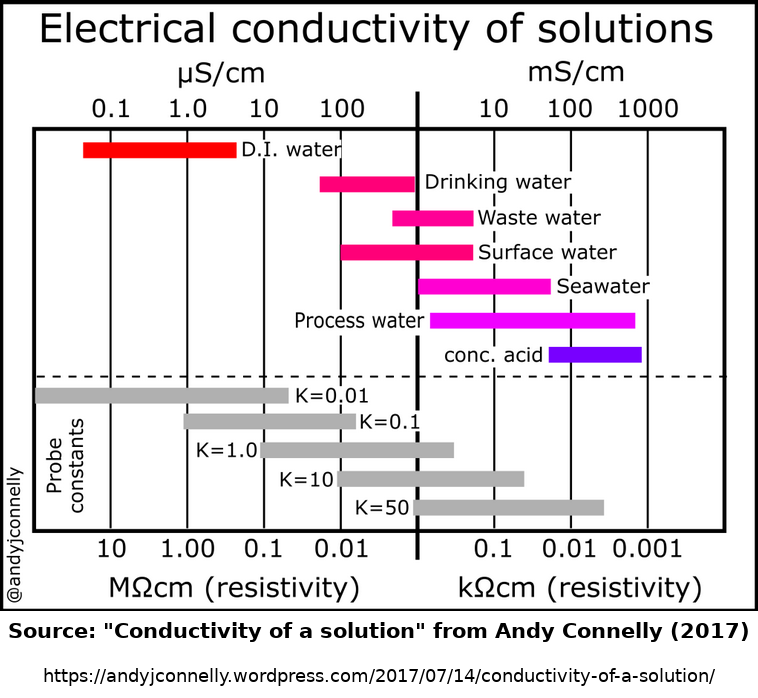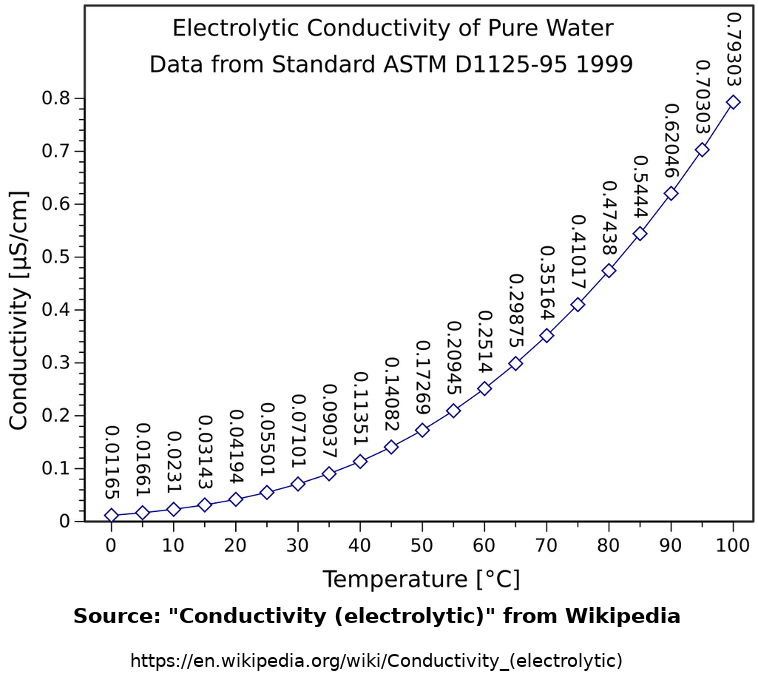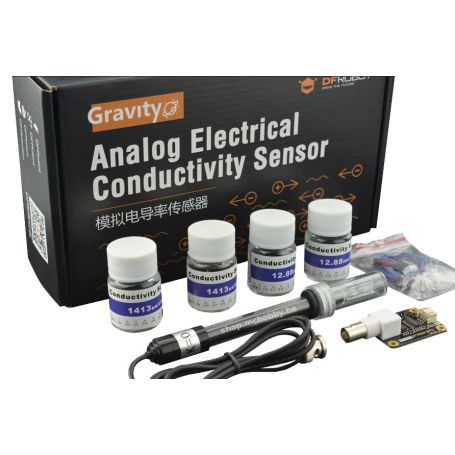Electrical conductivity of aqueous solutions (K 1, ECMeter) gravity, analog
Kit for Aqueous Electrical Conductivity measurement
- ECMeter K=1
- Supply: 3 - 5V
- Output: Analog Output 0-3.4V
- Detection range: 0 to 15mS/cm
- DFR300 (v2)
Payments are secured by LyraCollect, a French payment collection company.
It is possible to delivered to your home, to a pick-up point or picked up by appointment at MCHobby
We prepare, pack and ship your orders with great respect and care.
Electrical conductivity meter (sensor) with K=1
This sensor is an "analog electrical conductivity meter" (in version V2) used to to measure the electrical conductivity of aqueous solution. Pure water is not a good electrical conductor where as dirty water (containing ions in the solution) will allow the current to flow more easily.
So a very low Electrical Conductivity indicates a high quality (pure) water. Such sensor is used in water culture, aquaculture, environmental water detection and other quality fields for aqueous solution.
Conductivity is the opposite of resistance. The conductivity is the ability of a material to carry the current (where the "resistance" do resist to the current flow). Higher is the conductivity, less the material do resists to the current flow.
Liquids can also conduct current but it depends on the impurities/electrolytes/ions present in the water. The conductivity is a important parameter of water quality because it can reflect the extent of electrolytes present in water. Good quality water (pure water), should not have lot of electrolytes/impurities in it. As such, good quality water should have low conductivity.
Here some typical conductivity
- Pure water: 5.5 * 10E-6 S/m
- Drinking water: 0.005 to 0.05 S/m
- Sea water: 5 S/m
If you want to know more about the electrocal conductivity of solution, we may recommend to read "Conductivity of a solution" from Andy Connelly and "Conductivity (electrolytic)" from Wikipedia.

Important note: the electrical conductivity is sensitive to the temperature of the solution.

This new revision of the "analog electrical conductivity meter" improves the user experience and data precision. It can be used with 3 to 5v input voltage. The output signal is compatible with 5V and 3.3V microcontroler board (the output voltage stays within the range of 0 to 3.0 volts); The output signal is filtered by hardware to improve the stability; The excitation source use AC signal to reduce the polarisation effect on the probe (which improves the precision and life of the probe).
The software library uses two-point calibration method, and can automatically identify standard buffer solution, so simple and convenient.
With ECMeter, a microcontroler board (Arduino uno) and software library you can quickly achieve a electrical conductivity meter sensor without welding.
The key-features:
- 3.0 to 5.0V wide voltage input
- Hardware filtered output signal, low jitter
- AC excitation source, effectively reduce polarization
- Gravity connector to quick wire the board to the MicroControler
- BNC connector, to plug the probe on the amplifier board.
- Software library supports two-point calibration, and automatically identifies standard buffer solution, integrates temperature compensation algorithm
Tips & Trick
In order to ensure the measurement accuracy, it is strongly recommended to add a temperature sensor to the setup. Measuring the temperature will allows to perform a temperature compensation on the measured conductivity. DS18B20 waterproof temperature sensor can be used.
Recommendation of usage
- The probe is a laboratory-grade probe. Do not immerse in liquid for a long time. Otherwise this will shorten the life of the probe.
- Platinum black layer is attached to the surface of the sheet metal in the probe.It should avoid any object touching it. It can only be washed with distilled water, otherwise the platinum black layer will be damaged, resulting in inaccurate measurement.
Technical details
Signal Conversion Board (Transmitter) V2
- Supply Voltage: 3.0~5.0V
- Output Voltage: 0~3.4V
- Probe Connector: BNC
- Signal Connector: PH2.0-3Pin
- Measurement Accuracy: ±5% F.S.
- Board size: 42mm*32mm
Electrical Conductivity Probe
- Probe Type: Laboratory Grade
- Cell Constant: 1.0
- Support Detection Range: 0~20ms/cm
- Recommended Detection Range: 1~15ms/cm
- Temperature Range: 0~40°C
- Probe Life: >0.5 year (depending on frequency of use)
- Cable Length: 100cm
Content
For each order, you will receive the probe kit made with:
- 1x Electrical Conductivity Probe(K=1, Laboratory Grade)
- 1x Signal Conversion Board (Transmitter, V2)
- 2x Standard Buffer Solution 1413 µs/cm
- 2x Standard Buffer Solution 12.88 ms/cm
- 1x Gravity Analog Sensor Cable
- 2x Waterproof Gasket
- 1x Screw Cap for BNC Connector
- 4x M3 * 10 nylon pillar
- 8x M3 * 5 screw
Tutorial
- Analog electrical conductivity (k=1) (DFRobot, English)









